What Is a Diving Duck?
Diving ducks, also known as sea ducks, are typically found in large bodies of water such as lakes, rivers, and coastal bays.
When taking flight from the water’s surface, these diving ducks tend to patter along to get a running start instead of soaring like many other bird species. They are agile swimmers that dive far beneath the surface of the water to get food, which includes aquatic plants, fish, and crustaceans, among others. There are many members of the diving duck family. Here are a few of our favorites.

Diving Duck vs. Dabbling Duck: What Is the Difference?
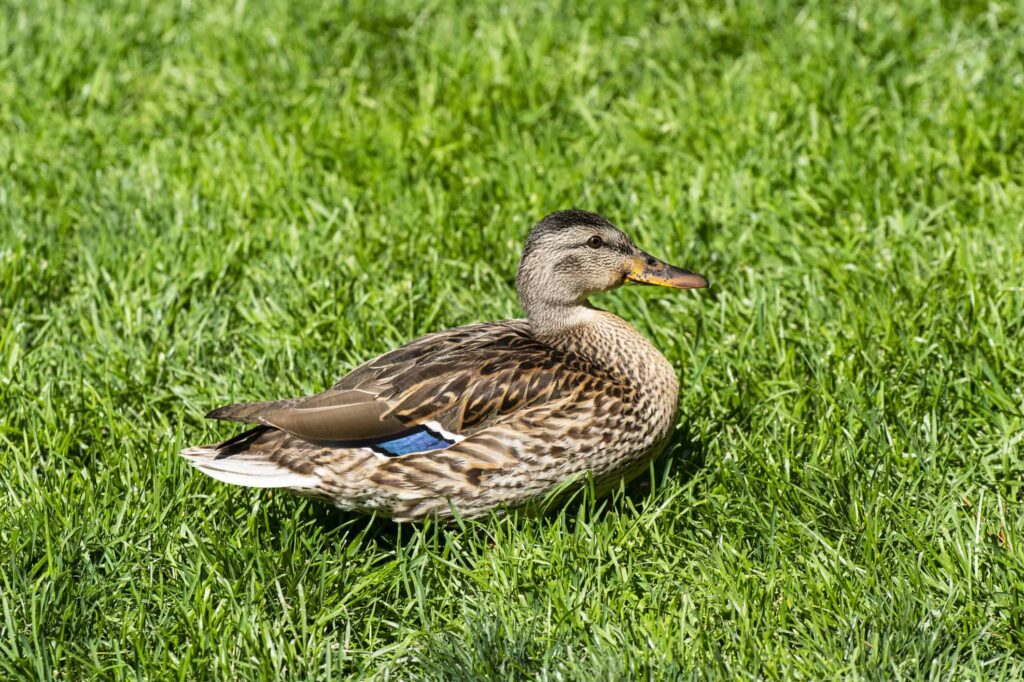
Unlike diving ducks, dabbling ducks have smaller feet because they do not dive.
©iStock.com/pichaitun
The key difference is the size of their feet. Dabbling ducks have smaller feet because they do not dive. Diving ducks are adept swimmers and dive underwater to find food. They use their large webbed feet to propel themselves quickly through the water to capture their prey. They also sit lower in the water than dabbling ducks.
Some diving ducks can be identified by the lack of iridescence in their speculum (secondary feathers), compared to many dabblers. Additionally, they have a more rapid wingbeat than most dabblers, making them faster fliers when necessary.
In contrast, dabbling ducks feed mostly on insects and vegetation near or on the surface. These types of ducks usually move by walking along the shoreline in search of food instead of diving into deeper waters, like divers. Dabblers have legs that are situated closer to their chest than divers. This feature allows them more agility in shallow waters.
How Deep Do Ducks Dive?
The ability to dive and forage underwater is an important skill many duck species have evolved. Most diving ducks stick to a diving depth of 6-10 feet, but some species can go much deeper. Long-tailed ducks and mergansers have been recorded diving up to 40 feet or more, making them some of the deepest divers among all duck species. However, the champion deep diver among ducks is undoubtedly the eider – it has been observed plunging as deep as 180 feet when searching for food! This remarkable feat allows these birds to access areas other waterfowl cannot reach.
Types of Diving Ducks
Diving ducks are birds that belong to the Anatidae family and are often called pochards or scaups. The family is quite large (174 species) and includes several aquatic birds, such as geese, ducks, and swans. They occur on every continent except Antarctica and are well adapted to floating, swimming, or diving in all sorts of climates. Here are some of our favorites below!
1. Barrows Goldeneye
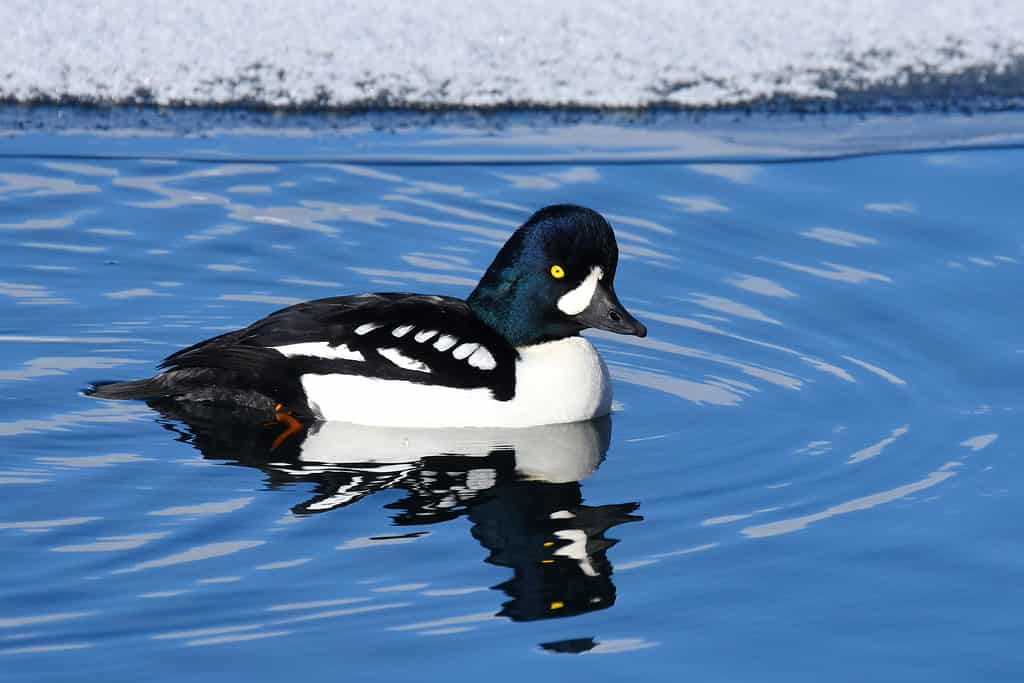
Barrow’s goldeneyes often return to the same nesting area year after year, and female birds typically lay between 6-12 eggs per clutch.
©Carrie Olson/Shutterstock.com
Barrow’s goldeneyes’ are a type of diving duck that nest in treed or open areas near lakes and ponds surrounded by thick plant matter, usually in a tree cavity, abandoned woodpecker hole, nesting box, cavity, or river bank. They often return to the same nesting area year after year, and female birds typically lay between 6-12 eggs per clutch.
Barrow’s goldeneyes can be difficult to differentiate from common goldeneye ducks when flying due to their similar size and shape. However, some unique features, such as their fluffy egg-shaped head, tall forehead, and short triangle-shaped bills, help distinguish them from resting common goldeneyes.
These ducks feed on various food sources depending on their environment. Freshwater habitats provide aquatic insects, crustaceans, small fish, fish eggs, and pondweeds. Marine environments offer mollusks (particularly blue mussels), seastars, and marine worms as sustenance.
The vast majority of this species’ population resides within North America during both the breeding season (spring/summer) and winter. Alaska is at one end of its range while the central United States marks out the other side – staying west of the Rocky Mountains throughout.
2. Bufflehead
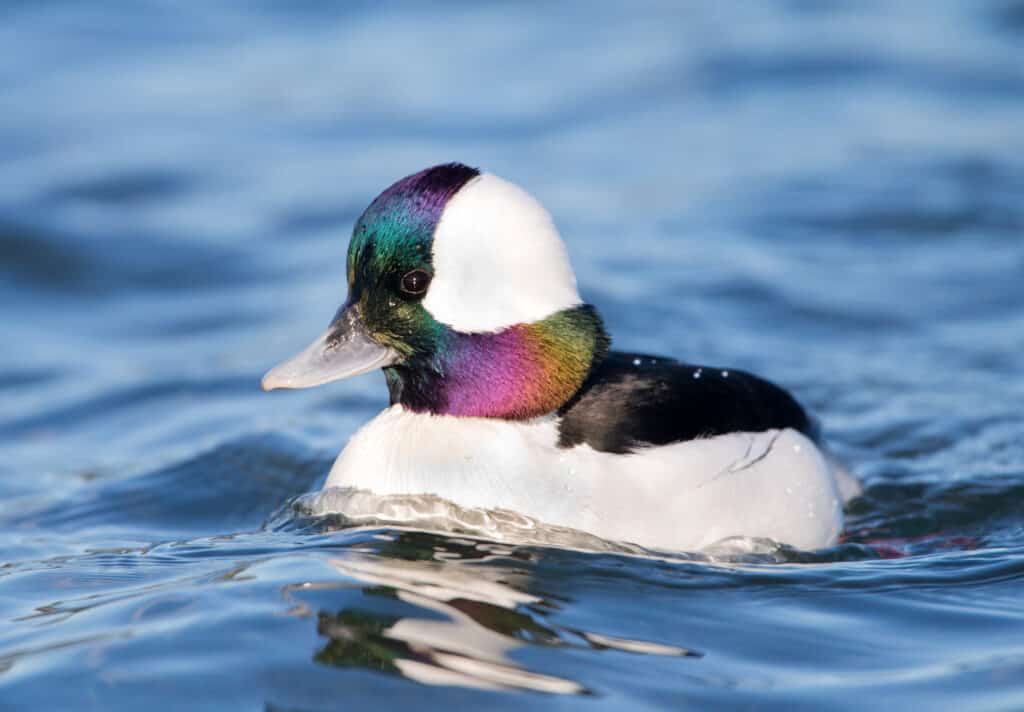
The peak of the bufflehead migration is in November.
©Birdiegal/Shutterstock.com
Buffleheads are small, stocky black and white diving ducks with a large white patch on the back of their heads. The white patch extends from one cheek to the other and forms a bushy crest. The rest of their head is covered in beautiful iridescent green and purple feathers.
They nest in cavities such as old tree holes or nest boxes near lakes and deep ponds that have associated temperate woodlands. Bufflehead will often congregate in groups on large lakes or major river systems until freeze-up occurs in the fall or right after thawing in the spring.
The Bufflehead’s diet changes seasonally depending on the availability of food sources. During winter, they focus more on plant matter due to decreased aquatic life available and frozen water. When the ice thaws, they prefer to eat mollusks, crustaceans, fish, and insects.
3. Common Merganser
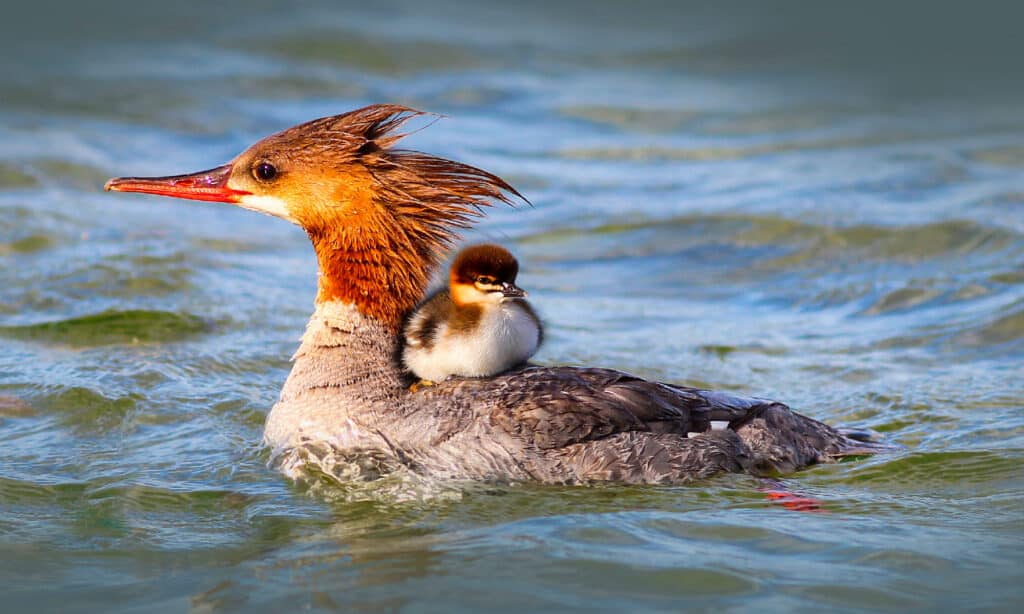
Common mergansers have long, narrow bills with serrated edges, which easily distinguishes them from other ducks.
©iStock.com/Anna39
Common mergansers are found in a variety of habitats, including clear-water rivers in forested regions and on mountainous terrain. Their nesting sites include tree cavities, nest boxes, cliff crevices, and the ground. The female common merganser typically lays an average of 9-12 eggs per clutch.
Common mergansers have long, narrow bills with serrated edges, which easily distinguishes them from other ducks. Compared to their cousins, such as eiders and goldeneyes, they appear less stocky when viewed up close but more elongated when flying in trailing lines close to the water’s surface. When hungry, they mainly feed on fish, amphibians, crustaceans, mollusks, and other invertebrates, which they obtain underwater in marine and freshwater habitats.
4. Harlequin Duck
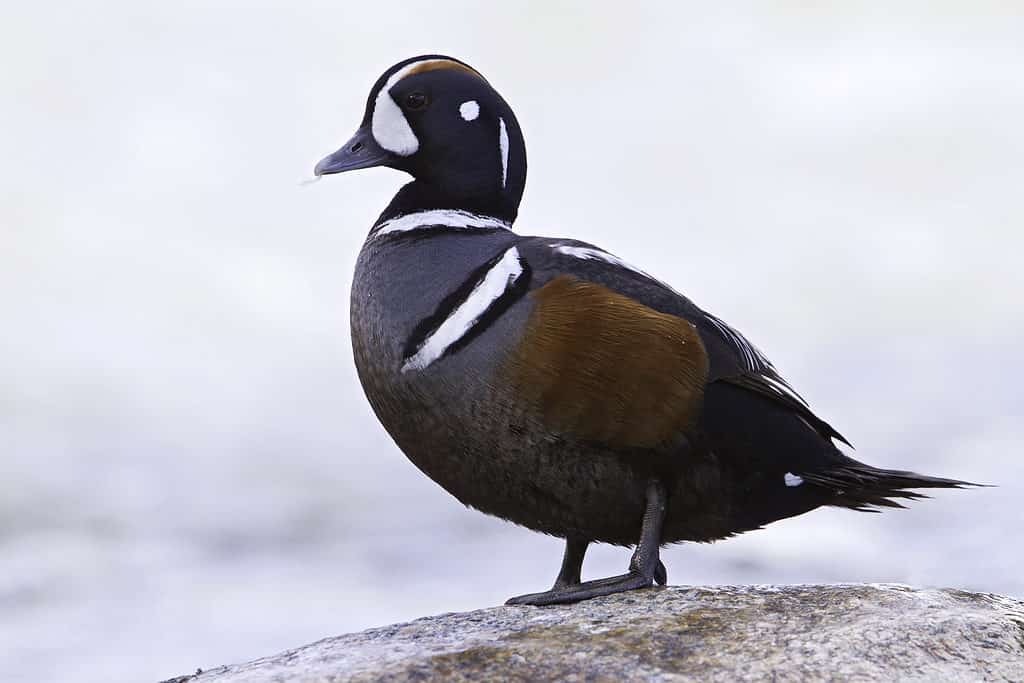
The Harlequin Duck feeds mainly on crustaceans, mollusks, insects, small fish, and fish eggs.
©iStock.com/AGAMI stock
The Harlequin duck is a unique species of diving duck that range along both the Atlantic and Pacific coasts. The males are quite distinct and can be easily identified by their deep slate blue body color with white stripes, crescents, and spots on the head, neck, and scapular.
They begin to mate in their second year of life, with females typically laying 5-6 eggs in nests made on small cliffs or tree cavities close to mountain streams and rapids. During the breeding season, they migrate toward rivers. In winter months, they move further out into coastal waters.
They feed mainly on crustaceans, mollusks, insects, small fish, and fish eggs. They hunt for food in rivers, lakes, ponds, and marine habitats, such as estuaries or ocean bays.
5. Redhead Duck
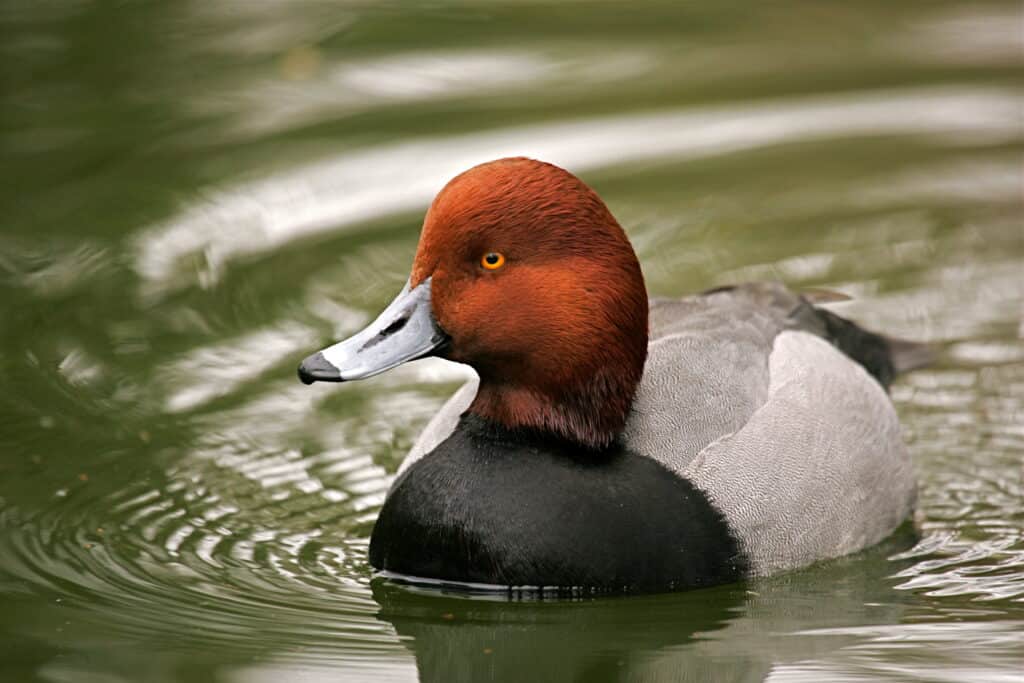
Male redheads are recognizable by their reddish heads.
©Tom Reichner/Shutterstock.com
Redhead ducks are a type of diving duck native to North America. They breed in the northern prairies of both the United States and Canada and in intermountain marshes of the West. During nesting season, they prefer non-forested areas with deep bodies of water that have permanent and fairly dense vegetation. Females lay an average of 7-10 eggs each year and often steal canvasback nests for their own use.
Male redheads are recognizable by their reddish heads. They have a gray beak tipped in black. They have brownish-black tail fins used for swimming through deep water with ease. Their diet consists mainly of seeds from pondweeds, wild celery, water lilies, grasses, and wild rice. They can also include mollusks, aquatic insects, and small fish in their diet when available.
6. Surf Scoter

The male surf scoter appears entirely black with white patches on its forehead and nape.
©Glenn Price/Shutterstock.com
The surf scoter is a diving duck species found only in North America. Its breeding season has been relatively unstudied. It is thought that the female chooses to nest in tundra among the brush or in wooded areas near a body of water, laying an average of 5-8 eggs each year.
The male surf scoter appears entirely black with white patches on its forehead and nape. It also boasts a large bill which is swollen on the top and truncated on the sides, with black feathers extending almost to its nostrils. When viewed from afar, this bill looks mostly orange due to its colorful nature: white, red, yellow, and black all combine together for this effect.
Surf scoters feed mainly on mollusks, crustaceans, insects, and small fish. They also enjoy green plant matter like pondweeds, wild celery, musk grass, and sedge seeds. While they can dive up to 30 feet deep into the water for their food sources, they generally prefer shallower waters in the zone of breaking waves.
7. King Eider

King eiders are some of the deepest diving ducks. They can reach depths of 180 feet!
©Agami Photo Agency/Shutterstock.com
King eiders usually breed in Arctic regions, preferring to nest in vegetation near wetlands, small ponds, lakes, or coastal inlets. The eggs are generally laid in a clutch of 4-5, and the female incubates them.
Male king eiders have striking plumage with black on their lower back, rump, scapulars, and tail coverts. They have an orange bill that curves up into an orange front shield trimmed with black and a pale blue ridge.
King eiders are some of the deepest diving ducks. They can reach depths of 180 feet! Their diet consists mainly of mollusks, crustaceans, and aquatic insects. However, there have been sightings of them feeding on various grasses and algae.
Summary of 7 Beautiful Diving Ducks
Here is the summary of 7 beautiful diving ducks:
| Rank | Ducks |
|---|---|
| 1 | Barrows Goldeneye |
| 2 | Bufflehead |
| 3 | Common Merganser |
| 4 | Harlequin Duck |
| 5 | Redhead Duck |
| 6 | Surf Scoter |
| 7 | King Eider |
The photo featured at the top of this post is © Agami Photo Agency/Shutterstock.com
Sources
- SORA, Available here: https://sora.unm.edu/sites/default/files/journals/auk/v116n03/p0792-p0805.pdf
- Ducks Unlimited, Available here: https://www.ducks.org/hunting/waterfowl-id/Diving
- Grand National Waterfowl Association, Available here: https://www.grandnationalwaterfowl.org/
- JSTOR, Available here: https://www.jstor.org/stable/3800128
- JSTOR, Available here: https://www.jstor.org/stable/3676166
Thank you for reading! Have some feedback for us? Contact the AZ Animals editorial team.






